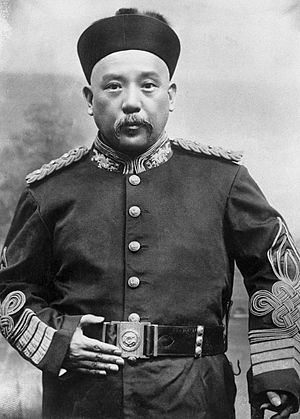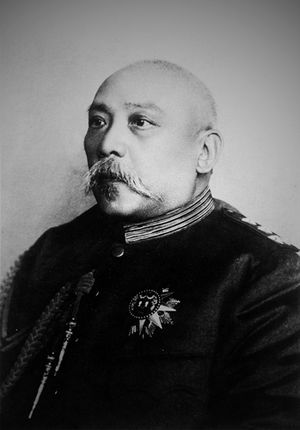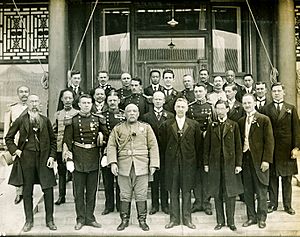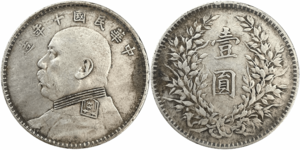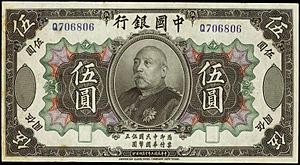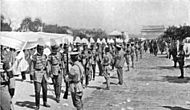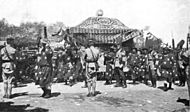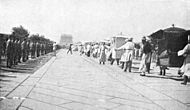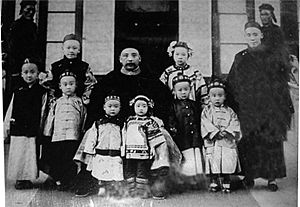Yuan Shikai facts for kids
Quick facts for kids
Yuan Shikai
|
|
|---|---|
|
袁世凯
|
|
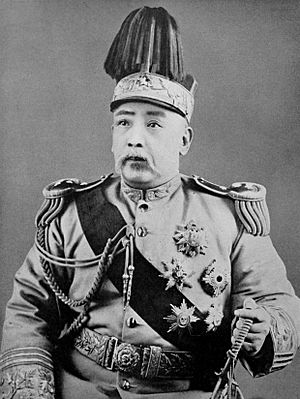
Yuan in 1915
|
|
| President of the Republic of China | |
| In office 22 March 1916 – 6 June 1916 |
|
| Premier | |
| Vice President | Li Yuanhong |
| Preceded by | Himself as Emperor of China |
| Succeeded by | Li Yuanhong |
| In office 10 March 1912 – 12 December 1915 |
|
| Premier |
|
| Vice President | Li Yuanhong |
| Preceded by | Sun Yat-sen |
| Succeeded by | Himself as Emperor of China |
| 2nd Prime Minister of the Imperial Cabinet | |
| In office 2 November 1911 – 10 March 1912 |
|
| Monarch | Xuantong Emperor |
| Preceded by | Yikuang, Prince Qing |
| Succeeded by | Qing dynasty ended Zhang Xun (1917) |
| Grand Councillor | |
| In office 4 September 1907 – 2 January 1909 |
|
| Monarch | |
| Secretary of Foreign Affairs | |
| In office 4 September 1907 – 2 January 1909 |
|
| Monarch | |
| Preceded by | Lu Haihuan |
| Succeeded by | Liang Dunyan |
| Viceroy of Zhili and Minister of Beiyang | |
| In office 7 November 1901 – 4 September 1907 |
|
| Monarch | Guangxu Emperor |
| Preceded by | Li Hongzhang |
| Succeeded by | Yang Shixiang |
| Provincial Governor of Shandong | |
| In office 6 December 1899 – 7 November 1901 |
|
| Monarch | Guangxu Emperor |
| Preceded by | Yuxian |
| Succeeded by | Zhang Renjun |
| Emperor of China | |
| In office 12 December 1915 – 22 March 1916 |
|
| Preceded by | Himself as President of China |
| Succeeded by | Himself as President of China |
| Personal details | |
| Born | 16 September 1859 Xiangcheng, Henan, Qing Empire |
| Died | 6 June 1916 (aged 56) Beijing, Republic of China |
| Cause of death | Uremia |
| Political party |
|
| Spouses |
|
| Children |
|
| Occupation | General, politician |
| Awards |
|
| Signature | |
| Military service | |
| Allegiance |
|
| Branch/service | |
| Years of service | 1881–1916 |
| Rank | Generalissimo |
| Battles/wars |
|
| Emperor of China | |
| Reign | 12 December 1915 – 22 March 1916 |
| Predecessor | Himself as President of the Republic of China |
| Successor | Himself as President of the Republic of China |
| Prime Minister | Lou Tseng-Tsiang |
| Yuan Shikai | |||||||||||||||||||||||||
|---|---|---|---|---|---|---|---|---|---|---|---|---|---|---|---|---|---|---|---|---|---|---|---|---|---|
| Traditional Chinese | 袁世凱 | ||||||||||||||||||||||||
| Simplified Chinese | 袁世凯 | ||||||||||||||||||||||||
|
|||||||||||||||||||||||||
| Courtesy name | |||||||||||||||||||||||||
| Traditional Chinese | 慰亭 | ||||||||||||||||||||||||
| Simplified Chinese | 慰亭 | ||||||||||||||||||||||||
|
|||||||||||||||||||||||||
Yuan Shikai (simplified Chinese: 袁世凯; traditional Chinese: 袁世凱; pinyin: Yuán Shìkǎi; 16 September 1859 – 6 June 1916) was a powerful Chinese military leader and government official. He became very important during the last years of the Qing dynasty. He played a big role in ending the Qing dynasty's rule in China in 1912. Later, he even tried to become the Emperor himself.
Yuan first tried to help the Qing dynasty by making many modern changes. These included updates to the government, money system, laws, and schools. He also helped create China's first modern army. This army and his control over the government helped him become a strong leader. In 1912, he convinced the last emperor, Puyi, to step down. After that, he became the first President of the Republic of China. In 1915, he tried to bring back the idea of an emperor in China, with himself as the Hongxian Emperor. But this didn't last long. He died in 1916, and his death led to a time when China's government was split into many parts, known as the Warlord Era.
Contents
Early Life and Beginnings
Yuan Shikai was born on September 16, 1859, in a village called Zhangying. His family, the Yuan Clan, was wealthy. They later moved to a fortified village called Yuanzhaicun, which was easier to defend from bandits.
Yuan's family was rich enough to give him a traditional Chinese education. When he was young, he loved riding horses, boxing, and having fun with friends. He wanted to work for the government, but he failed the important Imperial examinations twice. So, he decided to join the army instead, where many of his relatives served. He started his career in 1880 by buying a small official title, which was a common way to get ahead back then. He also married Yu Yisdong in 1876, and they had a son, Yuan Keding, in 1878. Yuan Shikai had many more wives throughout his life.
Time in Korea
In the 1870s, Korea was ruled by the Joseon dynasty. There was a struggle between those who wanted to keep Korea isolated and those who wanted to open up trade. Japan, which had recently modernized, started to challenge China's influence over Korea.
In 1882, a power struggle in Korea led to China sending troops to help. Yuan Shikai was chosen to train 500 Korean soldiers in modern warfare. He was also given a higher rank. In 1885, Yuan became the Imperial Resident of Seoul. This meant he was China's top official in Korea and advised the Korean government on many policies.
Tensions with Japan
China's growing influence in Korea worried Japan. Japan wanted to have equal power there. A rebellion in Korea, called the Donghak Rebellion, led both China and Japan to send more troops. Tensions grew when Japan refused to remove its forces.
China wanted to avoid war with Japan. Yuan was called back to Tianjin in July 1894, just before the First Sino-Japanese War officially began. Yuan had three Korean wives, and 15 of his children were from them.
Rise to Power in China
Yuan became well-known during the First Sino-Japanese War. He was in charge of Chinese forces in Korea but was called back to China before the main fighting started. This meant he avoided the shame of China's defeat.
As an ally of a powerful official named Li Hongzhang, Yuan was put in charge of the first New Army in 1895. Yuan made this army very modern and well-trained. This made his soldiers very loyal to him. By 1901, many of China's top military leaders were his former students or allies. The Qing government relied heavily on his army because it was close to the capital and very effective.
The Hundred Days' Reform
In 1898, the Qing government was divided. The Guangxu Emperor wanted big changes, known as the Hundred Days' Reform. But the Empress Dowager Cixi and her supporters thought these changes were too much. They planned to take back power.
Historians still debate Yuan's exact role. Some say he told Empress Cixi about the Emperor's plans, which led to the Emperor being put under house arrest. By siding with the Empress Dowager, Yuan became a powerful figure, but also an enemy of the Guangxu Emperor.
The Boxer Rebellion
In 1899, Yuan became the Governor of Shandong. During his time there, the Boxer Rebellion started. This was a movement against foreigners and Christians in China. Yuan made sure the Boxers were stopped in his province. He sided with the officials who wanted to work with foreign countries. He refused to join the Boxers in attacking foreign forces.
Yuan and other Chinese governors with modern armies ignored the Empress Dowager Cixi's declaration of war against foreign powers. They continued to stop the Boxers. Yuan's forces also helped foreign armies stop the Boxers after they captured Beijing in 1900. Yuan's army stopped many Boxers in the Zhili Province.
Yuan also started a modern college in Jinan, which used Western ideas for education.
Becoming a Powerful Official
In 1902, Yuan was promoted to a very important position: Viceroy of Zhili. This made him in charge of trade in North China and the Minister of Beiyang. Because he had helped stop the Boxer Rebellion, foreign countries trusted him. He got many loans to make his Beiyang Army even stronger. It became the most powerful army in China.
Yuan also created China's first police force in Tianjin. He helped make big changes to the government, like creating ministries for education and police. He also believed that Han Chinese and Manchus should be treated equally.
In 1905, Yuan suggested that Empress Dowager Cixi end the old Confucian examination system. She agreed and ordered a new system of schools like those in Japan. In 1908, Yuan helped create "Principles for a Constitution." This document suggested a government with a strong ruler, like Japan or Germany, and a parliament elected by 1917.
Yuan's army was mainly in charge of protecting Beijing. In November 1908, the Empress Dowager and the Guangxu Emperor died. Yuan was removed from his posts in January 1909. The official reason was a foot disease.
During his three years away from power, Yuan stayed in touch with his allies in the army. The Beiyang Army was still loyal to him. This meant Yuan held a lot of power between the Qing government and the revolutionaries who wanted to overthrow it.
The Wuchang Uprising and Republic
The Wuchang Uprising started on October 10, 1911. Many southern provinces declared they were independent from the Qing government. But the northern provinces and Yuan's Beiyang Army didn't take a clear side. Both the Qing government and the revolutionaries knew that Yuan's army was the only force strong enough to stop the rebellion.
The Qing government asked Yuan to return to power. He refused many times, using his "foot ailment" as an excuse. He waited for the right moment.
Finally, Yuan agreed and became prime minister on November 1, 1911. He immediately asked the regent to step down. This allowed Yuan to form a new government mostly made up of his trusted friends. The Empress Dowager even gave him a special noble title. Yuan's forces fought the revolutionaries and won back some cities. But Yuan knew that completely crushing the rebellion would make him less useful to the Qing. So, he started talking with the revolutionaries instead.
The Emperor Steps Down
The revolutionaries had chosen Sun Yat-sen as their first Provisional President of the Republic of China. But their military was weak, so they talked with the Qing government, with Yuan as the go-between. Yuan arranged for the child emperor Puyi to step down. In return, Yuan would become the President of the Republic of China.
Sun Yat-sen agreed to Yuan becoming president. But he wanted the capital to be in Nanjing. Yuan, however, wanted the capital closer to his military base in Beijing. Some people believe Yuan secretly arranged a fake uprising in Beijing to have an excuse not to leave. The revolutionaries agreed, and Beijing became the capital. Yuan Shikai was elected Provisional President on February 14, 1912, and officially took office on March 10.
Elections and Challenges
In February 1913, elections were held for the National Assembly. The Kuomintang (KMT), or "Chinese Nationalist Party," won by a lot. Song Jiaoren of the KMT wanted a government where the cabinet had more power than the president.
Song wanted to make sure the Parliament's power was protected from the president. This went against Yuan's goals, as Yuan wanted to have a lot of power as president. Song openly criticized Yuan's ambitions. When the KMT won the elections, it looked like Song would have a big say in choosing the prime minister and cabinet. On March 20, 1913, Song Jiaoren was shot and died two days later. Evidence pointed to people close to Yuan's government. Many believed Yuan was behind it, but he was never proven guilty.
Becoming Emperor
Tensions between the KMT and Yuan grew. The elected Parliament tried to control Yuan and create a permanent constitution. They also wanted a fair presidential election. The KMT was very critical of Yuan because he borrowed a lot of money from foreign banks. Yuan started to crack down on the KMT. He removed KMT members from the government.
The Second Revolution
Seeing his party in trouble, Sun Yat-sen fled to Japan in August 1913. He called for a "Second Revolution" against Yuan Shikai. Yuan then slowly took over the government, using his military power. He closed down the national and local assemblies. He replaced them with a new "Council of State." His trusted general, Duan Qirui, became prime minister.
Yuan then had himself elected president for a five-year term. He said the KMT was a rebellious group and removed all its members from Parliament. The KMT's "Second Revolution" failed. Yuan's troops easily defeated the uprisings. This made Yuan's power even stronger.
In January 1914, China's Parliament was officially closed. Yuan created a new "constitutional compact" that gave him almost unlimited power over China's military, money, foreign policy, and citizens' rights. He said that democracy had failed because of political fighting.
After his victory, Yuan changed how provincial governments worked. Each province had a military governor and a civil authority. This gave each governor control of their own army. This setup later led to the "warlord" period in China.
During Yuan's time as president, a silver coin with his picture was made. This coin became very common in China during the first half of the 20th century.
Japan's Demands
In 1914, Japan took a German colony in China called Qingdao. In January 1915, Japan secretly sent a list of demands to China, known as the Twenty-one Demands. Japan wanted more control over Chinese businesses, land, and even police.
When these demands became public, Chinese people were very angry. There were protests and boycotts of Japanese goods. With help from Britain and the United States, Yuan got Japan to drop some of the demands. But he still accepted the less harsh ones. This made Yuan's government less popular with the Chinese people.
Becoming Emperor Again
| Emperor of China | |
|---|---|
| 皇帝 | |
|
Imperial
|
|
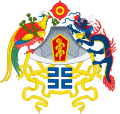
Imperial Emblem
|
|
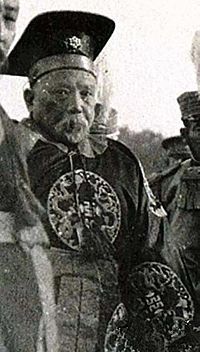
Hongxian Emperor
|
|
| Details | |
| Style | His Imperial Majesty |
| First monarch | Hongxian |
| Last monarch | Hongxian |
| Formation | 12 December 1915 |
| Abolition | 22 March 1916 |
| Residence | Forbidden City, Beijing |
To make his power even stronger, Yuan started to bring back old traditions from the Qing dynasty. He took part in rituals at the Temple of Heaven, acting like an emperor. In late 1915, rumors spread that people wanted to bring back the idea of an emperor. Many of Yuan's supporters, like Yang Du, encouraged him to become emperor. They believed Chinese people were used to having an emperor and that it would bring stability. Some foreign experts also agreed. Japan even offered to support Yuan's ambition if he accepted their demands.
On November 20, 1915, Yuan held a special meeting where everyone voted for him to become emperor. On December 12, 1915, Yuan "accepted" and declared himself Emperor of the Chinese Empire. He chose the era name Hongxian, meaning "Constitutional Abundance." The new empire was supposed to officially begin on January 1, 1916. Yuan ordered expensive items for his new role, like a huge porcelain set and imperial robes.
Reactions to the New Empire
The Hongxian Emperor expected everyone in China and other countries to support him. But he was wrong. Many of his closest supporters left him. There were protests all over China against him. Foreign governments, including Japan, did not recognize him as emperor. Sun Yat-sen, who was in Tokyo, started working to overthrow him. Yuan's own sons argued over who would be the next "Crown Prince." Even loyal generals like Duan Qirui and Xu Shichang left him.
Giving Up the Throne and Death
Because of all the opposition, the Hongxian Emperor kept delaying his official crowning ceremony. But his reputation was ruined. Province after province declared their disapproval. On December 25, 1915, the military governor of Yunnan, Cai E, rebelled. This started the National Protection War. Other provinces soon followed.
Yuan officially gave up being emperor on March 22, 1916, after only 83 days. This was because of the growing revolts and his declining health. But this was not enough for his enemies, who wanted him to resign as president too. More provinces rebelled. Yuan died from a kidney disease called uremia on June 6, 1916, at age 56.
Yuan's body was moved to his home province of Henan and buried in a large tomb in Anyang. In 1928, his tomb was robbed by soldiers.
Yuan had one wife and many other wives, who gave him 17 sons and 15 daughters. His most well-known sons were Yuan Keding and Yuan Kewen.
Yuan Shikai's Legacy
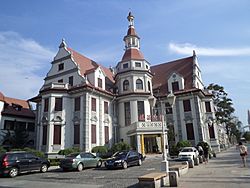
Most historians in China view Yuan's rule negatively. He did bring many modern changes to laws and society. He also trained and organized one of China's first modern armies. However, the loyalty he built in the army disappeared after his death. This weakened the central government. Yuan also borrowed a lot of money from foreign countries, which some say hurt China's standing in the world. He also allowed Japan to gain many advantages in China.
However, some historians point out that Yuan was ambitious for both himself and his country. Even though he sometimes went against the constitution, he tried to build on the reforms of the late Qing dynasty. He wanted to create a strong and stable government for China. He also tried to improve the legal system and invited foreign advisors to help.
After Yuan's death, there was an attempt to bring back the Republic. But this effort was not strong enough to control the country. China then entered a period called the Warlord Era. During this time, different military leaders, or warlords, controlled different parts of China. Yuan is sometimes called "the Father of the Warlords" because his actions helped set the stage for this period. However, he had tried to create a modern, unified army. But later in his life, he seemed to put his own desire to be emperor ahead of his military reforms. He ruled using force and bribery, which hurt the early dreams of the Republic.
In a TV show called Towards the Republic, Yuan is shown as a smart leader and a clever politician in his early years. His decision to become emperor is shown as being influenced by others, especially his son, Yuan Keding.
A large stone tortoise with a tablet honoring Yuan Shikai was placed in Anyang after his death. It was partly fixed in 1993.
Other Names for Yuan Shikai
Chinese men before 1949 often used different names. Yuan's courtesy name was "Weiting." He also used the pen name "Rong'an." Sometimes people called him by the name of his birthplace, "Xiangcheng."
Awards and Honors
Family Members
Yuan Shikai had a wife, Yu Yishang, and several other wives. He had 17 sons and 15 daughters.
- Yuan Keding (1878–1958)
- Yuan Kewen (1889–1931)
- Yuan Keliang
Yuan's grandson, Luke Chia-Liu Yuan (1912–2003), was a Chinese-American physicist. He was married to the famous physicist Chien-Shiung Wu. Yuan's great-grandson, Li-Young Lee (1957–), is a writer and poet.
See also
 In Spanish: Yuan Shikai para niños
In Spanish: Yuan Shikai para niños
- Beiyang Army
- History of the Republic of China
- Republic of China Armed Forces
- Sino-German cooperation (1926–1941)


